1Hardware:

It’s one of those moments when you question a company for launching the same kind of product at the same time for the same price bracket but with different names. Both the Redmi Y3 and Redmi 7 are powered by the same Qualcomm Snapdragon 632 Processor along with Adreno 506 GPU, 3GB RAM and 32GB of storage. While it’s too early to comment on the performance of the two phones, we can expect it to be the same since both of them offer the same Chipset with the same software experience.
Winner: None
2Design:

With the launch of the Redmi 7 and Redmi Y3, Xiaomi has gone for flashy representations of its smartphones. Both phones come with gradient finishes that gives a premium feel to the device on first glance. It’s up one’s individual preference when it comes to choosing between the Redmi Y3 or the Redmi 7. The Redmi 7 comes in Lunar Red, Comet Blue and Eclipse Black colours while the Redmi Y3 will be available in Bold Red, Elegant Blue and Prime Black coloured back panels.
Winner: None
3Display:

Both the Redmi 6 and Redmi Y3 devices feature 6.26-inch HD+ displays with screen resolution of 1520 x 720 pixels, 19:9 aspect ratio and 269 ppi pixel density. The panel on the front is so identical that the screen-to-body ratio on both of them is precisely 81.5 percent with Corning Gorilla Glass 5 at the top. We reviewed the Redmi 7 and we can expect the Redmi Y3 to have similar brightness and viewing angles.
Winner: None
4Camera:

The major difference between the two phones comes in the camera department.
The Redmi Y3, being a little more expensive device, features a 32-megapixel selfie shooter with an f/2.2 Aperture and 0.8µm pixel size. The Redmi 7 comes with a lesser resolution 8-megapixel camera for selfies and video calling though it comes with AI face unlock and AI beauty mode.
Both phones feature a dual rear camera setup with a combination of 12-megapixel primary sensor with LED Flash, 1.12um pixel size, f/2.2 aperture, a secondary sensor of 2-megapixel. The phones come loaded with an AI Beauty 4.0 mode along with support for Auto HDR, Screen Flash, AI Portrait Selfie, 80-degree wide angle lens, palm shutter, and Full HD selfie video support.
Winner: Redmi Y3 when clicking selfies.
5Software:

Considering the similarities between the two phones, it’s pretty obvious that the two Xiaomi phones will follow each other’s suits in terms of software as well. The Redmi 7 and Redmi Y3 run on Android 9.0 Pie with MIUI 9, which isn’t exactly the latest version of the software from Xiaomi. The interface comes with a host of bloatware apps, which has been one major drawback of MIUI interface. But you can delete most of the applications to free up some storage on your smartphone.
Winner: None
6Battery and Connectivity:

Both the Redmi Y3 and Redmi 7 feature a 4,000mAh battery with 10W fast charging. The only advantage the Redmi Y3 gets is through the more modern USB Type-C port that it gets instead of the Micro USB port on the Redmi 7. However, the Redmi 7 additionally supports aptX HD for HD voice calling and music through Bluetooth.
Winner: Redmi Y3 for USB-C support, Redmi 7 for aptX
7Verdict:

Right off the bat, it was pretty clear that the reason Xiaomi released the Redmi Y3 and Redmi 7 inside the same price segment at the same time is to expand its portfolio to include more phones for minute differences in price. However, it also feels like a foolish move from Xiaomi since a person eyeing for a phone at Rs 9k wouldn’t shy to look at a phone which is available for Rs 10k, if they’re getting more features for the additional Rs 1,000. Nevertheless, the Redmi 7 and Redmi Y3 are decent options in the basic category with good performance in attractive forms.


